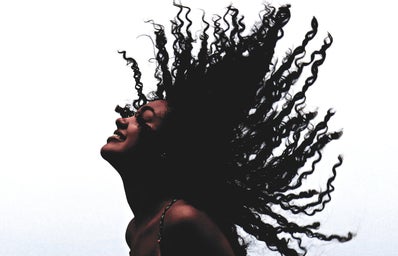A couple months ago, I came across an Instagram page of a person called Taiba Taiba, a young Nigerian creative who uses hair braiding in her artwork. The posts consisted of decorative mirrors, chairs, hats, bags, and even shoes completely created out of braids. Along with these were also intricately structured braided styles showcased on multiple black women. I was in awe, to say the least. It was the first time I had ever seen anybody present black hairstyling through the medium of artwork, and in such a unique way too. Curiosity peaked, I immediately looked up who Taiba Taiba is. Hardly an unknown, Taiba Akhuetie, London native, was revealed to be the CEO of her own hair brand, Keash London, and the creative force behind her own East London art exhibit titled, We Need Some More Black In Hair. The exhibit consists of braided sculptures that demonstrate her expert braiding skills. In an interview with journalist Mahoro Seward for i-D, Taiba described the exhibit as a reflection of the shared experience that black people have with trying to “unlearn Western, white-centric ideals” and to celebrate black hair.
As a young Nigerian woman who has, and still continues to, struggle with my kinky hair, Taiba Akhuetie’s work struck a chord with me. Having spent all of my life in white environments catering to what a white person deems as “presentable hair”, my relationship with my hair has been incredibly rocky. Although my relationship with my hair is not as damaged as it was before, it’s still a point of insecurity from time to time. So to see black hair being so openly praised and explored in art felt unfamiliar to me. In most cases of black hair care in art and the media in general, especially with 4c hair like mine, it’s usually excluded or written off as “difficult”. And yes, while it does have its own difficulties, it’s also important to recognize its versatility and beauty, which Taiba does beautifully. Hair for black women is a canvas and a means of expressing ourselves and appreciating our natural hair. We Need Some More Black In Hair acknowledges this and translates it into artwork. Using braiding in everyday objects like clothing and chairs to me can be interpreted as how durable black hair is in a way that other types of hair aren’t. The many different pieces in the exhibit are representative of its ability to transform. The exhibit is the perfect way to showcase how black hairstyling is truly a difficult-to-master art form that should be recognized rather than overlooked. I hope to see this exhibit when it moves to New York in early 2022 and I look forward to what Taiba does next and how her artwork can further emphasize the importance of black culture.
On her collection Taiba states, “It didn’t really make sense at first to use hair in this way, but I’m so glad I have done this as there’s a strong underlying message about black culture, and I feel I’ve created something very unique.” Taiba’s exhibit is definitely one that will stay with me forever.


